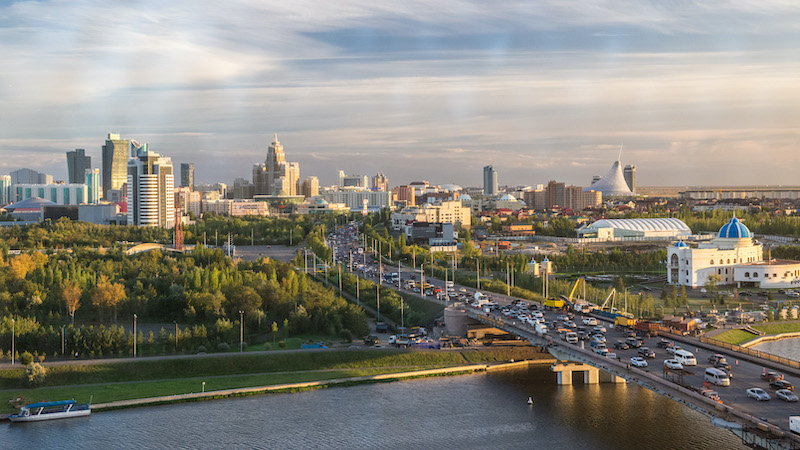ASTANA – As the impacts of climate change continue to escalate, the frequency and intensity of natural hazards are expected to rise, posing greater threats to lives and livelihoods in Central Asia and South Asia. In response to this growing risk, governments are increasingly implementing financial protection measures to aid disaster response, including floods and earthquakes, yet not all countries possess sufficient resources to adequately address these challenges. Thomas Kessler, principal finance specialist for disaster insurance at the Asian Development Bank (ADB), offers valuable perspectives on how countries in Central Asia can collaborate effectively to bridge this funding shortfall.

Photo credit: ADB.
The aftermath of last year’s catastrophic floods in Pakistan impacted approximately 33 million people and caused an estimated $30 billion in damages. This year, a powerful 6.5 magnitude earthquake struck Pakistan, affecting neighboring Afghanistan and five Central Asian republics. Last month, the Abai Region in eastern Kazakhstan witnessed the devastating destruction of up to 60,000 hectares of land due to raging forest fires, claiming the lives of 14 individuals.
These events serve as a stark reminder of the inherent vulnerability faced by Central Asia and its neighboring countries to a range of natural hazards, including floods and earthquakes. Compounded by the impending consequences of climate change, which will intensify the frequency and severity of such calamities, the region now confronts an alarming gap in its ability to protect against these risks.
“Resilience against disasters caused by natural hazards is critically important in parts of Asia and the Pacific that are prone to earthquakes and climate risk. Countries can reduce their exposure by building flood defenses, retrofitting infrastructure, and setting up evacuation and response plans. These steps protect lives, livelihoods, and economies. But even with well-planned and executed measures, there will always be some level of risk,” said Kessler.
In the Central Asia Regional Economic Cooperation (CAREC) Program region, which includes Central Asia, parts of South Asia and South Caucasus, Mongolia, and the People’s Republic of China, rapid economic development entails the value of these assets at risk from natural calamities has significantly increased.
“According to our report, floods and earthquakes cause average annual losses of about $4.7 billion in the region. This is the long-term expected losses per year from disaster events, averaging out more frequent but less severe events, with events that may happen less often but can be more damaging,” said the expert.
He emphasized the need for planning financing mechanisms ahead of disaster to avoid unplanned borrowing, budget reallocations, and humanitarian support.
“This works for countries with ample fiscal space that can quickly access financing. But governments with limited spending power tend to rely on humanitarian support, which is vital but can vary in terms of amounts, speed, and reliability,” he said.
Pre-arranged financing can be a critical source of funding to repair damaged infrastructure and help the economy recover. This financing mechanism has two categories, risk transfer and risk retention, which are not mutually exclusive.
“So-called risk transfer strategies include instruments such as insurance and disaster relief bonds. They shift potential losses to external parties such as insurance companies or bond investors, which are paid a premium for taking on that risk. Risk-retention strategies are where the government sets up a reserve fund for losses associated with adverse events, including through savings and contingent disaster financing loans,” said Kessler.
When it comes to addressing losses linked to frequent yet relatively low-intensity events, risk-retention measures prove to be a more suitable solution.
“Flash flooding, for example, can occur every few years due to intense rain. The frequency of such events means it is not viable for governments to transfer this risk to third parties, while the cost of damage generally won’t hamper government spending priorities,” the expert explains.
In contrast, risks stemming from infrequent yet severe disasters, such as a devastating earthquake or national-scale flooding, are often best addressed through risk transfer mechanisms.
The ability of countries to secure disaster risk financing hinges upon countries’ diverse risk profiles.
“The Kyrgyz Republic and Uzbekistan do have some form of risk retention mechanisms in place, but risk and vulnerability are high in areas where agriculture and manufacturing activities are also important. Azerbaijan, Georgia, and Kazakhstan also already have risk retention measures that can cover losses from floods, earthquakes and emergency response needs. But direct losses could exhaust these resources, prompting the need for risk transfer instruments to support reconstruction costs,” said the expert.
Regional cooperation is central to efforts to bridge the financing gap. Setting up a regional risk transfer mechanism can be one of the first steps.
“For instance, countries can collaborate to purchase insurance collectively. This would diversify the levels of risk among the different countries and allow them to share fixed and administrative costs—hence lowering overall costs,” said Kessler.
Regional cooperation also extends to the exchange of practice and expertise. However, for a regional mechanism to become efficient, three factors need to be addressed, according to Kessler.
“First, the risk financing should meet the needs of all member countries to ensure their commitment. Second, the risks covered by the protection plans should be well-balanced so that the cost of the risks covered in any one country won’t exhaust the resources required to cover the risks of another country. (…) Third, countries should be incentivized to put in place climate mitigation and adaptation efforts to limit the rising costs of protection and improve the resilience of their economies and people to disaster events,” said the expert.

